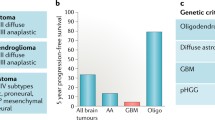Abstract
Chronic myelogenous leukemia (CML) is an example of a “well-differentiated” neoplasm that develops following neoplastic transformation of a precursor cell. The biology of astrocytic neoplasms can be interpreted in light of concepts that have emerged from studies of the myeloproliferative disorders. Astrocytomas may arise from a pluripotential precursor cell whose progeny, although transformed, retain the ability to differentiate, and do so along astrocytic lines. The result is a neoplasm composed of “mature” tumor cells, similar one to another, and resembling normal astrocytes. Malignant change, like blast crisis in CML, then occurs as a consequence of further molecular genetic events leading to accelerated growth and maturation arrest in a previously differentiating neoplastic cell. This hypothesis challenges the conventional view that astrocytomas arise from astrocytes and that malignant change occurs as a result of dedifferentiation. Extensions of this hypothesis may be relevant to the biology of other glial tumors.
Similar content being viewed by others
References
Bennett DC: Differentiation in mouse melanoma cells: initial reversibility and an on-off stochastic model. Cell 34:445–453, 1983
Rundles RW: Chronic myelogenous leukemia. In: Williams WJ, Beutler E, Erslev AJ, Lichtman MA (eds) Hematology. New York, McGraw-Hill, 1983, pp 196–214
Greaves MF: “Target” cells, cellular phenotypes, and lineage fidelity in human leukemia. J Cell Physiol supplement 1:113–125, 1982
Silverstein MN: Myeloproliferative diseases. Postgrad Med 61:206–210, 1977
Murphy S: Polycethemia vera. In: Williams WJ, Beutler E, Erslev AJ, Lichtman MA (eds) Hematology. New York, McGraw-Hill, 1983, pp 185–196
Silverstein MN: Primary thrombocythemia. In: Williams WJ, Beutler E, Erslev AJ, Lichtman MA (eds) Hematology. New York, MCGraw-Hill, 1983, pp 218–221
Groopman JE: The pathogenesis of myelofibrosis in myeloproliferative disorders. Ann Intern Med 92:857–858, 1980
Greaves MF: Differentiation-linked leukemogenesis in lymphocytes. Science 234:697–704, 1986
Paterson JA: Dividing and newly produced cells in the corpus callosum of adult mouse cerebrum as detected by light microscopic radioautography. Anat Anz Jena 153:149–168, 1983
Kim SU, Moretto G, Shin DH, Lee VM: Modulation of antigenic expression in cultured adult human oligodendrocytes by derivatives of adenosine3′,5′-cyclic monophosphate. J Neuro Sci 69:81–91, 1985
Kleihues P, Rajewsky MF: Chemical neuro-oncogenesis: role of structural DNA modifications, DNA repair and neural target cell population. In: Rosenblum ML, Wilson CB (eds) Brain Tumor Biology. Basel, Karger, 1984, pp 1–16
Cushing H, Wolbach SB: The transformation of malignant paravertebral sympathicoblastoma into a benign ganglioneuroma. Am J Pathol 3:203–220, 1927
Feigin I, Epstein F, Mangiardi, J: Extensive advanced maturation of medulloblastoma to astrocytoma and ependymoma. JNO 1:95–108, 1983
Jones-Villeneuve EMV, McBurney MW, Rogers KA, Kalnins VI: Retionic acid induces embryonal carcinoma cells to differentiate into neurons and glial cells. J Cell Biol 94:253–262, 1982
Raff MC, Miller RH, Noble M: A glial progenitor cell that develops in vitro into an astrocyte or an oligodendrocyte depending on culture medium. Nature 303:390–396, 1981
Choi BH, Kim RC: Expression of glial fibrillary acidic protein in immature oligodendroglia. Science 223:407–409, 1984
Bailey P, Cushing HA: A classification of tumors of the glioma group on a histogenic basis with a correlated study of prognosis. Philadelphia, Lippincott, 1926
Cairncross JG: Astrocytomas. In: Fedoroff S, Vernadakis A (eds) Astrocytes: Cell Biology and Pathology of Astrocytes, Volume 3. Orlando, Academic Press, 1986, pp 338–356
Westermark B: Growth factors and oncogenes in human glioma. JNO 4:93, 1986
Rakic P: Limits of neurogenesis in primates. Science 227:1054–1056, 1985
Rubinstein LJ, Herman MM, Vandenberg SR: Differentiation and anaplasia in central neuroepithelial tumors. In: Rosenblum ML, Wilson CB (eds) Brain Tumor Biology. Basel, Karger, 1984, pp 32–48
Author information
Authors and Affiliations
Rights and permissions
About this article
Cite this article
Cairncross, J.G. The biology ofAstrocytoma: Lessons learned from chronic myelogenous leukemia—hypothesis. J Neuro-Oncol 5, 99–104 (1987). https://doi.org/10.1007/BF02571297
Issue Date:
DOI: https://doi.org/10.1007/BF02571297




